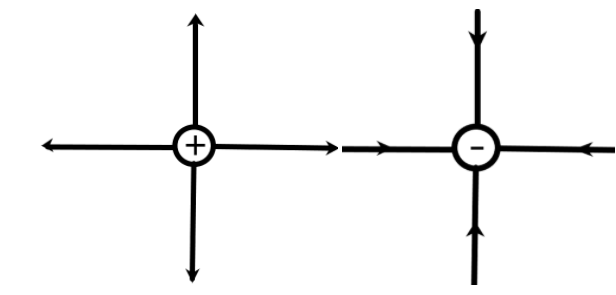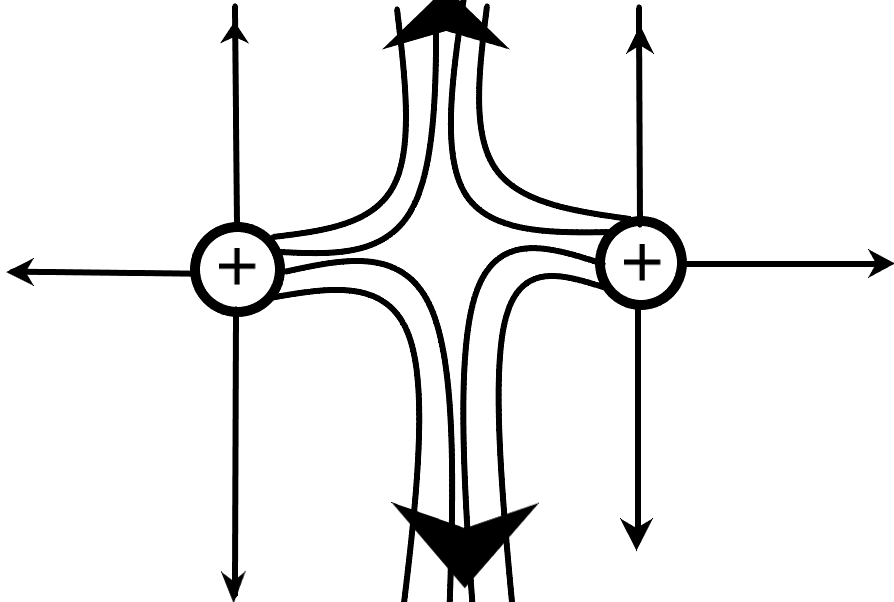
Write two properties of electric field lines.
Answer
557.4k+ views
Hint: We need to understand what an electric field is to understand its behaviour and properties. The characteristics of an electric field is charge dependent and is a directional quantity or a vector quantity which can produce a force on a charge.
Complete step by step answer:
The Electric field is the Coulomb’s electric force per unit charge acting on a charged particle due to another charge kept at a distance. It is the directional quantity of the force experienced by a charge kept in the presence of another charge. The electric fields are described by lines of force whose direction is dependent on the charge in the system and the charge that causes the electric field.
The electric field is given by the relation from Coulomb’s law as –
\[\begin{align}
& \text{Electric field,} \\
& E=\dfrac{\text{Electrostatic Force}}{\text{Charge in the field}} \\
& \text{Coulomb }\!\!'\!\!\text{ s force,} \\
& F=\dfrac{1}{4\pi {{\varepsilon }_{0}}}\dfrac{Qq}{{{r}^{2}}} \\
& \Rightarrow \text{ }E=\dfrac{1}{4\pi {{\varepsilon }_{0}}}\dfrac{Q}{{{r}^{2}}} \\
\end{align}\]
This is the relation for a charge in an electric field due to a charge Q.
Now, let us consider the different properties of an electric field line.
1)The electric field lines seem to emerge or come out from a positive charge and go into a negative charge as shown below. The electric field lines converge in case of negative charge and diverge in case of a positive charge.

2)The electric field lines never cross each other: If two or more charges are present, the electric field lines develop a resultant field line without crossing or joining. This case is impossible, as the electric field being a vector quantity can possess only a single direction and magnitude at a given point in space. The electric field lines due to two charges of equal sign are as shown below –

These are the main properties of electric field lines.
Note:
The electric field lines by convention start from the positive charge and end in the negative charge. The direction of an electric field is therefore, given as from the positive charge to the negative charge for all applications in the electrostatics and magnetostatics.
Complete step by step answer:
The Electric field is the Coulomb’s electric force per unit charge acting on a charged particle due to another charge kept at a distance. It is the directional quantity of the force experienced by a charge kept in the presence of another charge. The electric fields are described by lines of force whose direction is dependent on the charge in the system and the charge that causes the electric field.
The electric field is given by the relation from Coulomb’s law as –
\[\begin{align}
& \text{Electric field,} \\
& E=\dfrac{\text{Electrostatic Force}}{\text{Charge in the field}} \\
& \text{Coulomb }\!\!'\!\!\text{ s force,} \\
& F=\dfrac{1}{4\pi {{\varepsilon }_{0}}}\dfrac{Qq}{{{r}^{2}}} \\
& \Rightarrow \text{ }E=\dfrac{1}{4\pi {{\varepsilon }_{0}}}\dfrac{Q}{{{r}^{2}}} \\
\end{align}\]
This is the relation for a charge in an electric field due to a charge Q.
Now, let us consider the different properties of an electric field line.
1)The electric field lines seem to emerge or come out from a positive charge and go into a negative charge as shown below. The electric field lines converge in case of negative charge and diverge in case of a positive charge.

2)The electric field lines never cross each other: If two or more charges are present, the electric field lines develop a resultant field line without crossing or joining. This case is impossible, as the electric field being a vector quantity can possess only a single direction and magnitude at a given point in space. The electric field lines due to two charges of equal sign are as shown below –

These are the main properties of electric field lines.
Note:
The electric field lines by convention start from the positive charge and end in the negative charge. The direction of an electric field is therefore, given as from the positive charge to the negative charge for all applications in the electrostatics and magnetostatics.
Recently Updated Pages
Master Class 12 Business Studies: Engaging Questions & Answers for Success

Master Class 12 Economics: Engaging Questions & Answers for Success

Master Class 12 English: Engaging Questions & Answers for Success

Master Class 12 Maths: Engaging Questions & Answers for Success

Master Class 12 Social Science: Engaging Questions & Answers for Success

Master Class 12 Chemistry: Engaging Questions & Answers for Success

Trending doubts
What are the major means of transport Explain each class 12 social science CBSE

Which are the Top 10 Largest Countries of the World?

Draw a labelled sketch of the human eye class 12 physics CBSE

How much time does it take to bleed after eating p class 12 biology CBSE

Explain sex determination in humans with line diag class 12 biology CBSE

Differentiate between homogeneous and heterogeneous class 12 chemistry CBSE




